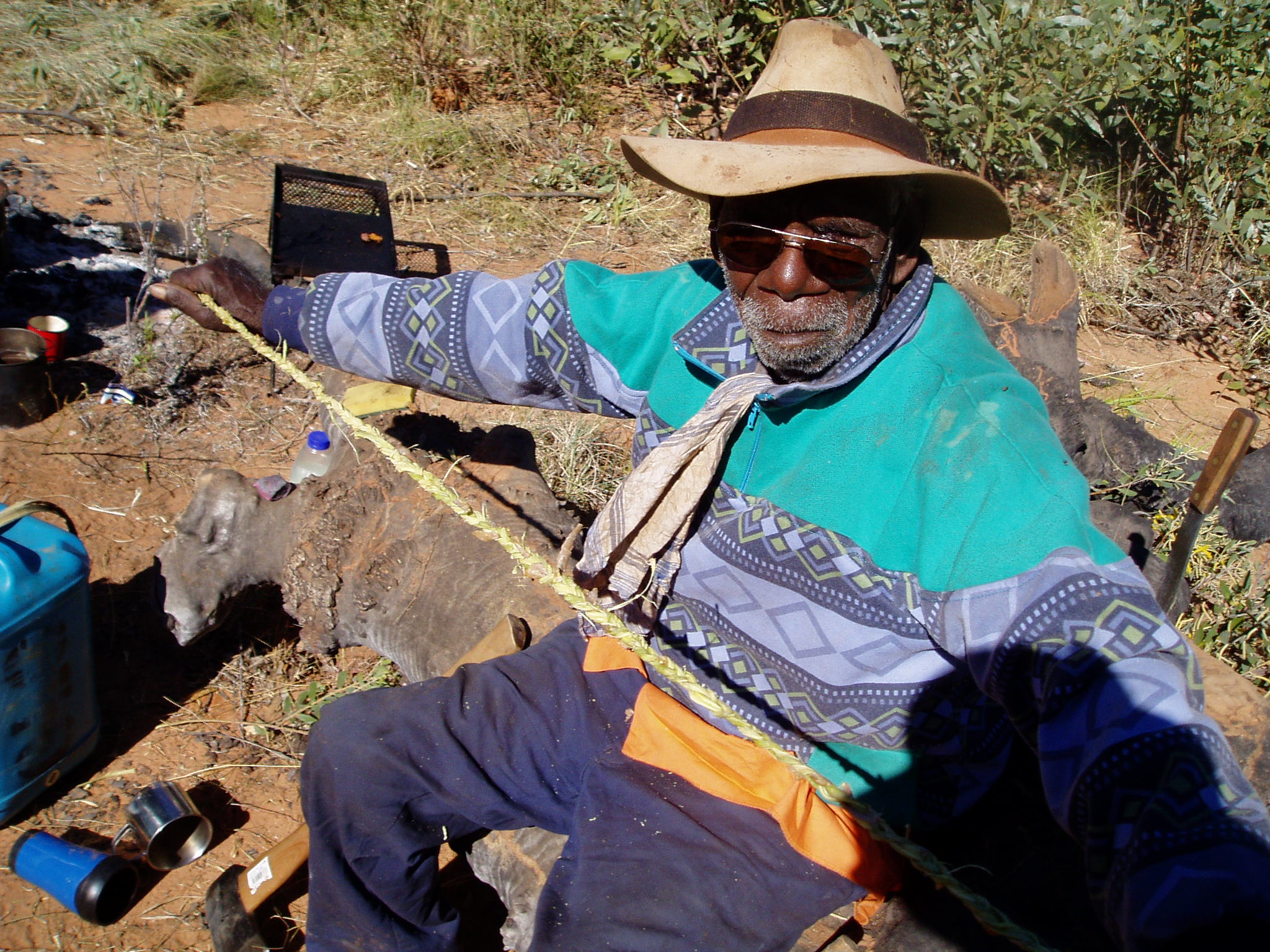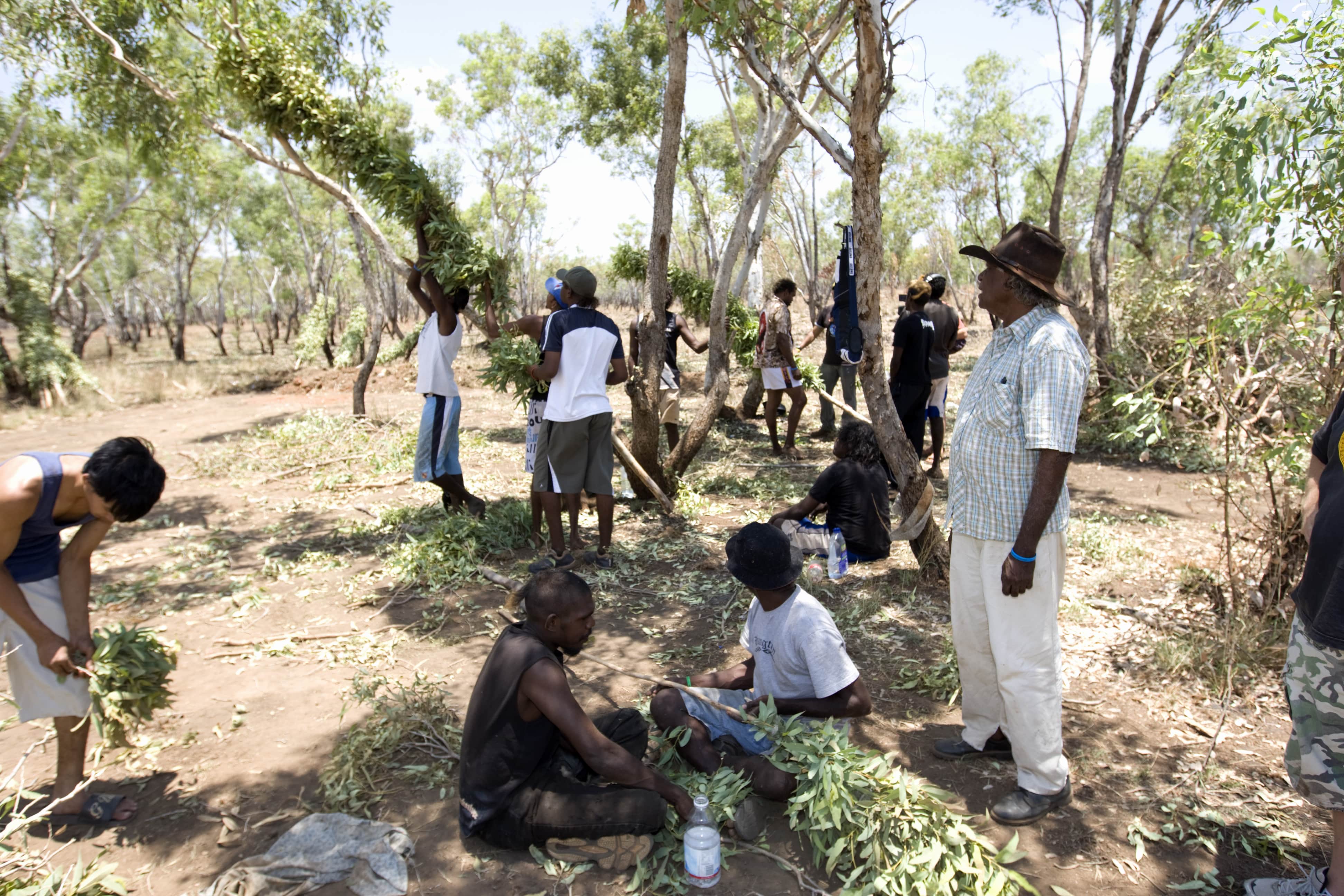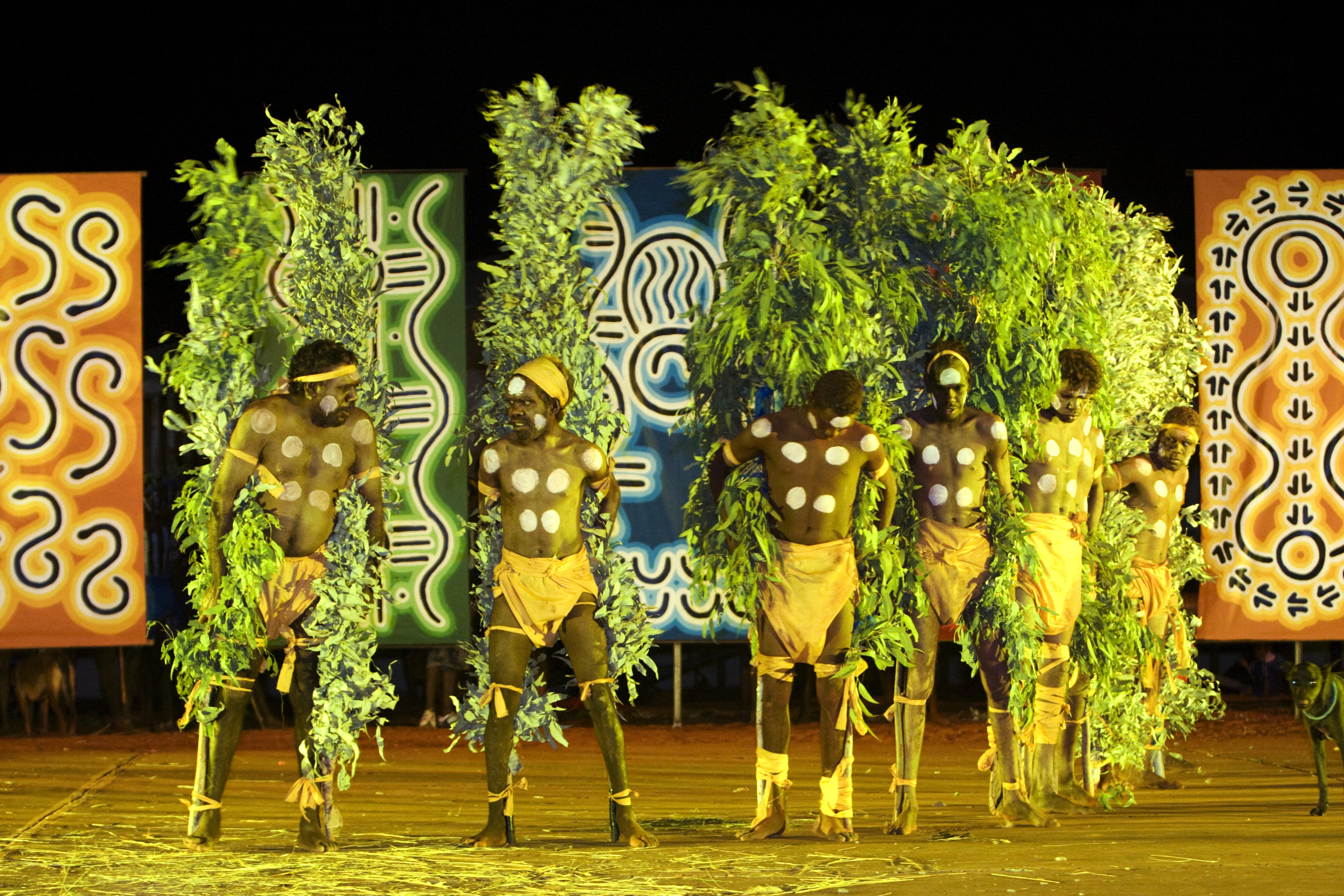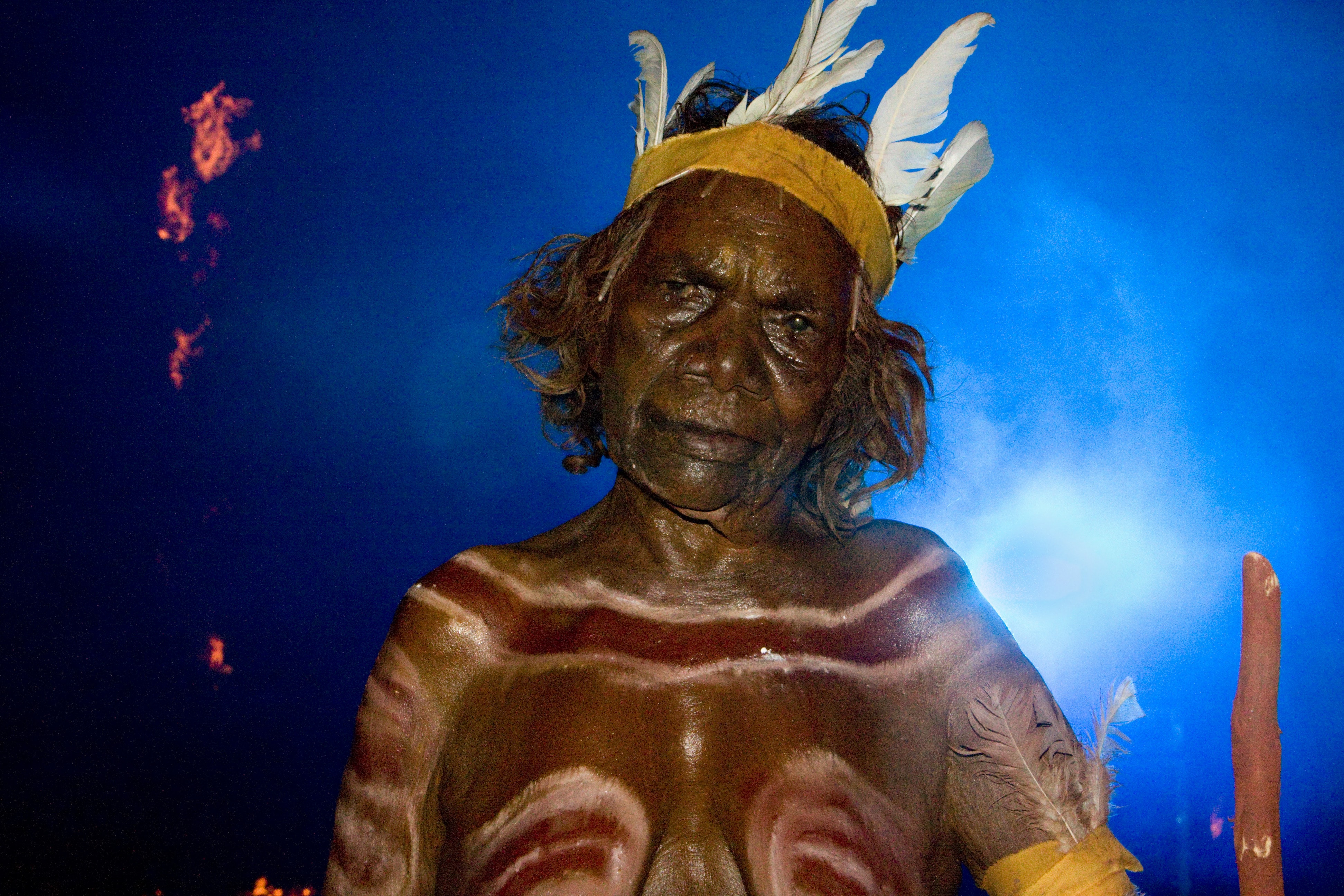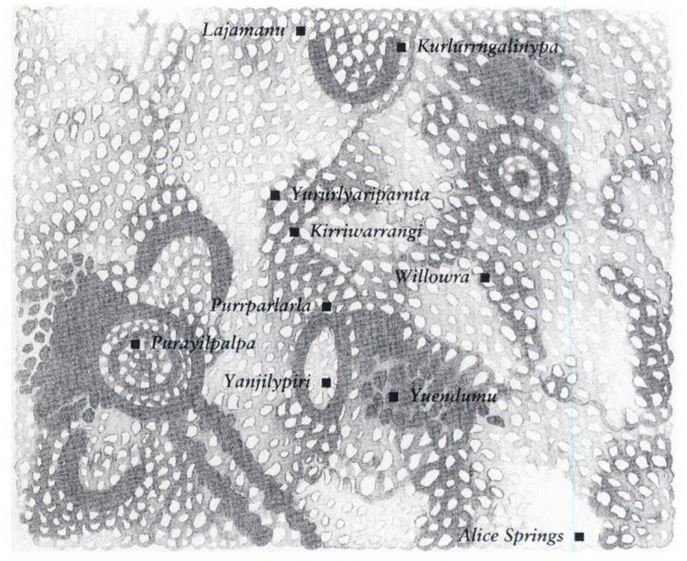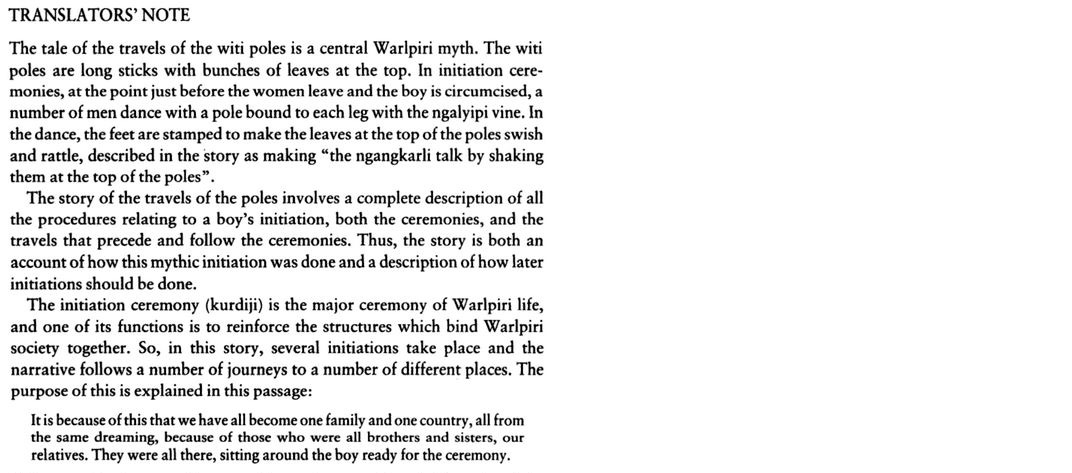Milpirri Banner - KURLUNGALINPA (Buchanan Hills)
Dreaming
This banner is the site Kurlungalinpa (Buchanan Hills.) It is connected with Ngarrka Dreaming. Ngarrka means initiated man and this Dreaming is central to Warlpiri ceremonial life. These ancestral men brought the kurdiji (young boy’s initiation) ceremony to Warlpiri people; they perform the ceremony in the Dreaming and this is a guide to how it should be performed today. Kurlungalinpa is a main place on the Ngarrka track where the Kurdiji was performed. Ngarrka dreaming and Kurlungalinpa are also connected with Witi (Ceremonial Poles Dreaming), Ngalyipi (Snake Vine Dreaming), Munga (Night Dreaming). In the design the straight lines in the centre are the Witi Poles which are long timber poles covered in gumtree leaves . The “S” shaped lined are windbreaks called yunta in Warlpiri. These are small walls made of branches, leaves or spinifex which Warlpiri put on the ground to block the wind in camp, or while sleeping. Kurlungalinpa is a range of hills but it is also the wind break that fell from the sky in the Dreaming. (In other versions of this design the curved “s” lines are ngalyipi (snake vine) which is used to tie the Witi poles to the dancers’ legs), The curved “C” lines are Japaljarri/Jungarrayi and Napaljarri/Nungarrayi ancestral people.
Belonging to Skin Groups
Japaljarri, Jungarrayi, Napaljarri and Nungarrayi (Yellow Group)
Place
Kurlungalinpa (Buchanan Hills, about 100km south east of Lajamanu).
Drawn By
Myra Nungarrayi Patrick/Herbert 2005
More information
In Lajamanu: Elder Margaret Martin Nungarrayi can speak about this dreaming. (Note: there are other Traditional Owners in Lajamanu and Yuendumu.) Watch Margret Martin Nungarrayi and Myra Herbert Nungarrayi talking with Miles Holmes and Tim Newth about the Kurlungalinpa design on the video below.
Dreaming Track
Biddy Long Nungarrayi states that Ngarrka (Initiated men Dreaming) bought the initiates from Manduwa in Gurindji country through Kurlungalinpa. At Kurlungalinpa the ceremony changes to Kurdiji, the initiates travelled in the night (munga) and therefore that dreaming is also connected with the night. The initiates went south though Purrparlarla on to Yinintiwalkuwalku (a site at Lake Mackay).
Moral of the story
Milpirri director Steve Wanta Jampijinpa Patrick states that the moral of this myth is about consequences and responsibility, about young people becoming initiated and having to make decisions about becoming active members of Warlpiri society. The two witi represents the choice between following the Law on one hand, and being without Law on the other.
See the public part of the Kurdiji ceremony with men wearing witi poles. Taken by Ludo Kuipers, Sat Jan 21, 1978 in Lajamanu - Photo
Language Stories
Ngarrka ngulaji wati kurdiji-jangka, manu kurduku-palangu. Manu karntakurlu ngarrkaji.
Ngarrka is a man who has been circumcised or who is a father or a husband.
Ngalyipi, kujaka watiya warirninjayani yangka kankarlarrakari, ngalyipi kujaka pardi watiyarla, panungkajala ngari ka watiyaju pardi manja-rlangurla, manangkarrarla, warirninjarra ka yani yangka kankarlarra, pijaraju wirilki. Palkaju ka nyina yunkurrmu-piya, kala ngari wiri-wirilki. Miyi ngarninja-wangulku kulalpalu yapangku nganjarla. Yampimi kalu ngawu-jala. Kala nyanungurla kujaka nyina - yarla-pama-piya, kujaka parrka muku-ngarni ngalyipi, ngulaju ngalyipi-pamarlu.
That Snakevine (Ngalyipi, Tinospora smilacin) that twists up around trees, the ngalyipi vine that grows on trees, it grows on lots of trees in both spinifex country and in the mulga scrub, it climbs up and around them, and has big leaves. It has berries like mistletoe berries, but bigger. They are inedible. People don't eat them. They leave them because they are no good. However, that thing like the yam grub (yarla-pama) that lives on it, that eats up all the leaves of the ngalyipi, it is the ngalyipi-pama (Snakevine grub).
Nyampu watiya ngalyipi ngulaju nyurnukurlangu. Yangka kalalunyanu junmangku pajurnu, ngulaju kalalunyanu warurnu murrumurru wiri.
This Snakevine is used by sick people. Like when someone has been cut with a knife, they would wind the vine around the part that was injured.
Witikingarntirli kalalu ngalyipi manu. Ngulajangka kalalu yirrarnu kurdijirla. Ngalikirrikirlirli kalalu pakarnu kurdijikirra manu kalalu puyu-pungu. Ngulajangka kalalu warurnu witiji.
They used to gather Snakevine in preparation for the witi ceremony. They used to put it onto a shield. They would beat it as it lay on the shield. Then they would tie the witi poles on with it.
Nyampu ngalyipi, ngulaju ka karri nyiyakantikantiki - parrajaku kanjaku, witiki warirninjaku, yampinyiki, miyalu murrumurruku. Manu kalalu yapangku parla ngalyipi kuuny-ngarnu miirntaparntarlu.
This Snake vine, it is used for everything. For carrying coolamons, for tying around witi poles, for wrapping up belongings, for tying around aching stomachs and also people used to suck the vine's leaves when they had a cold.
Further Reading
The Dreaming Stories at Kurlungalinpa connect Gurindji people, Kartanagarru people, Northern and Southern Warlpiri peoples. They have been recorded in various places.
Link here to Barbara Glowczewski's, (2001) Dream Trackers CD-ROM: Yapa Art and Knowledge of the Australian Desert, to read more, listen to songs, and watch films of the Kurlungalinpa story - Video / Story
Read more of the travels of the Witi Poles as told by Ngarlinjiya Mary Robertson Nungarrayi in the book, “Warlpiri dreamings and histories, Yimikirli : newly recorded sayings from Aboriginal elders of Central Australia” / translated by Peggy Rockman Napaljarri and Lee Cataldi. Walnut Creek, Calif. Alta Mira Press, c1994.
Read more of the Ngarrka story in Mervyn Meggit’s classic, Warlpiri ethnography “Desert People" - Story
European History
Read more about the famous bushman and drover called Nathaniel Buchanan who gave Kurlungalinpa its European name - Story
